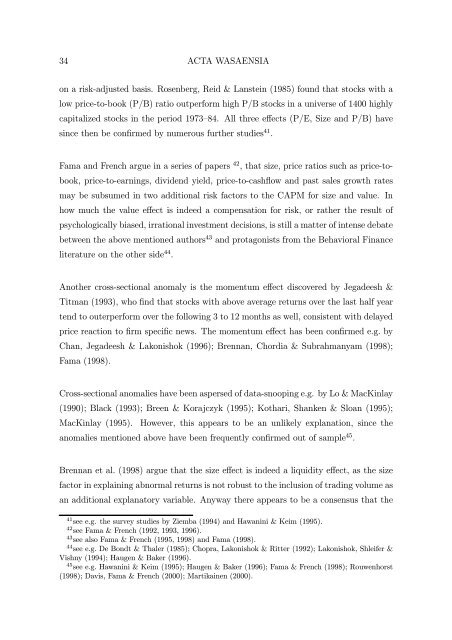BERND PAPE Asset Allocation, Multivariate Position Based Trading ...
BERND PAPE Asset Allocation, Multivariate Position Based Trading ...
BERND PAPE Asset Allocation, Multivariate Position Based Trading ...
You also want an ePaper? Increase the reach of your titles
YUMPU automatically turns print PDFs into web optimized ePapers that Google loves.
34 ACTA WASAENSIAon a risk-adjusted basis. Rosenberg, Reid & Lanstein (1985) found that stocks with alow price-to-book (P/B) ratio outperform high P/B stocks in a universe of 1400 highlycapitalized stocks in the period 1973—84. All three effects (P/E, Size and P/B) havesincethenbeconfirmed by numerous further studies 41 .Fama and French argue in a series of papers 42 , that size, price ratios such as price-tobook,price-to-earnings, dividend yield, price-to-cashflow and past sales growth ratesmay be subsumed in two additional risk factors to the CAPM for size and value. Inhow much the value effect is indeed a compensation for risk, or rather the result ofpsychologically biased, irrational investment decisions, is still a matter of intense debatebetween the above mentioned authors 43 and protagonists from the Behavioral Financeliterature on the other side 44 .Another cross-sectional anomaly is the momentum effect discovered by Jegadeesh &Titman (1993), who find that stocks with above average returns over the last half yeartend to outerperform over the following 3 to 12 months as well, consistent with delayedprice reaction to firm specific news.Themomentumeffect has been confirmed e.g. byChan, Jegadeesh & Lakonishok (1996); Brennan, Chordia & Subrahmanyam (1998);Fama (1998).Cross-sectional anomalies have been aspersed of data-snooping e.g. by Lo & MacKinlay(1990); Black (1993); Breen & Korajczyk (1995); Kothari, Shanken & Sloan (1995);MacKinlay (1995). However, this appears to be an unlikely explanation, since theanomalies mentioned above have been frequently confirmed out of sample 45 .Brennan et al. (1998) argue that the size effect is indeed a liquidity effect, as the sizefactor in explaining abnormal returns is not robust to the inclusion of trading volume asan additional explanatory variable. Anyway there appears to be a consensus that the41 see e.g. the survey studies by Ziemba (1994) and Hawanini & Keim (1995).42 see Fama & French (1992, 1993, 1996).43 see also Fama & French (1995, 1998) and Fama (1998).44 see e.g. De Bondt & Thaler (1985); Chopra, Lakonishok & Ritter (1992); Lakonishok, Shleifer &Vishny (1994); Haugen & Baker (1996).45 see e.g. Hawanini & Keim (1995); Haugen & Baker (1996); Fama & French (1998); Rouwenhorst(1998); Davis, Fama & French (2000); Martikainen (2000).
















